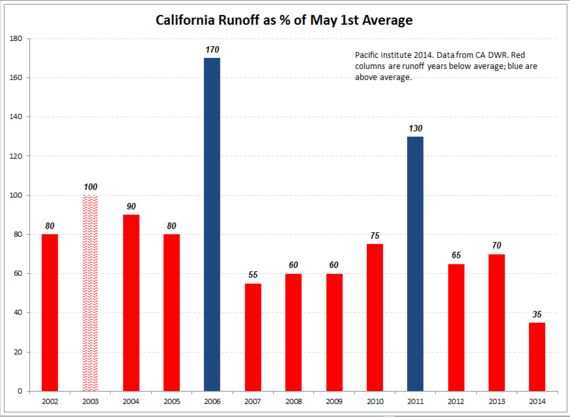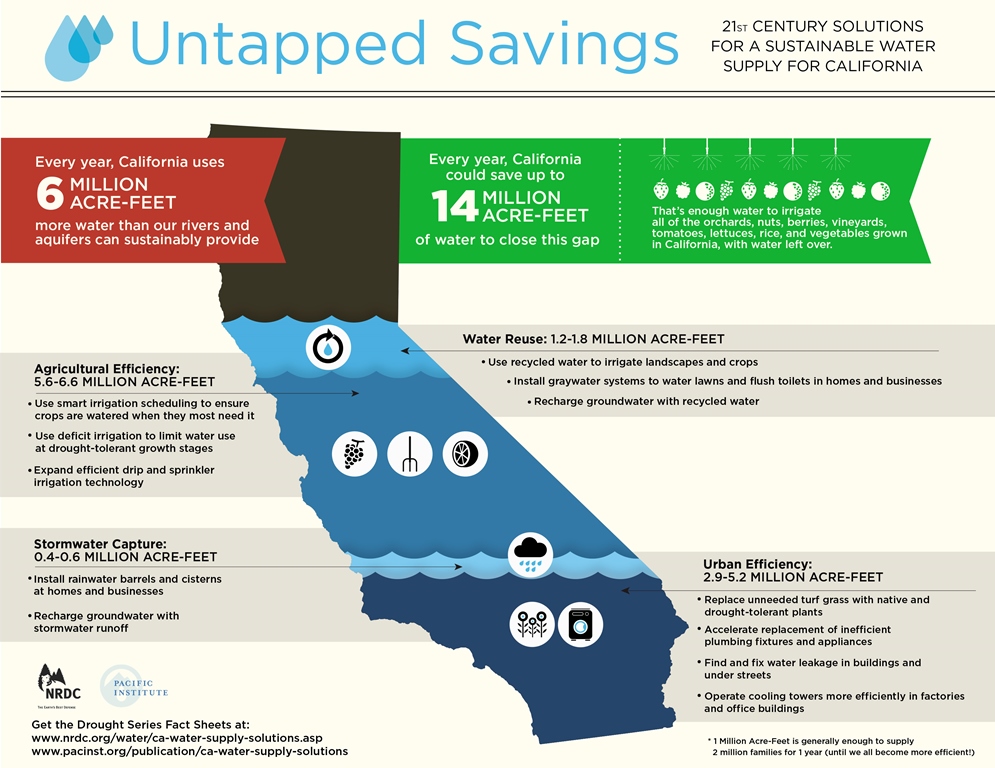By Peter Gleick, President
For over 150 years, Californians have argued, litigated, yelled, and otherwise fought over water. California is a big state – we have redwood forests, desert regions, mountains, coasts, rich agricultural lands, amazing natural ecosystems. And overall, we have a pretty good amount of water.
The problems with California’s water are that it is highly seasonal, highly variable, and poorly managed. Now, halfway through the second decade of the 21st century, we’ve hit the wall. California is in a drought – some call it the third year of a drought, but it could also be called the tenth dry year out of the last thirteen (see Figure 1). Even if next year brings some relief, our water problems will remain.

The problem is that even in wet years, California has passed the point of “peak water.” We have maxed out the renewable water available in our rivers – allocating to users more than nature provides even in a wet year. We are unsustainably overdrafting our groundwater – turning a renewable resource into a non-renewable resource – and we are plunging toward an economic, social, and political catastrophe in the groundwater basins of the Central Valley. We are past the point of “peak ecological water” – the point where our use of water now causes far more ecological harm than it provides benefit. Overall, on average, we use at least six million acre-feet a year more than we should.
Everyone who works on California water issues knows these things. Everyone who works on California water knows that “business as usual” cannot continue. The arguments have always been on how to change our policies to bring our use into line with nature’s limits.
Today, four studies have been released by the Pacific Institute, Natural Resources Defense Council, and researchers from the University of California, Santa Barbara. These studies analyze four solutions to California’s water problems that are proven to work, widely available, and cost effective. Taken together, they have the potential to expand existing supply or cut current demand by a total of between 11 and 14 million acre-feet a year – a vast amount of water (see Figure 2). Implementing these strategies will take time and effort and money – they require incremental actions on the part of all Californians, from homeowners and residents to industry to water utilities to state and federal agencies.

Source: Pacific Institute and NRDC, 2014. (Full size infographic available here.)
But these four strategies, and others not evaluated here, are central to any permanent solution for California’s water problems. (A summary of these studies can be found, here.)
What a thought. We have within our hands, the ability to end California’s water wars and move to a sustainable system that supports our growing population, a strong agricultural sector, and a healthy environment. Here, in a nutshell, is what these studies propose:
- We must expand current efforts to improve the efficiency of water use in homes and industries. In particular, while we often see calls for voluntary cutbacks and changes in behavior during drought, far more effective are permanent improvements in efficiency. The state has already made progress in this area, but our urban water use remains too high and much more potential exists to continue to replace inefficient appliances, reduce waste and leaks, and fundamentally change the nature of our outdoor landscape away from water-intensive lawns and gardens to low water-use plants and gardens. (Here is the.pdf of the urban efficiency study.)
- We must expand current efforts to improve the efficiency of water use in the agricultural sector, by accelerating the shift to better irrigation technologies and practices. The goal here is to grow more food and fiber with less water. Some innovative farmers have already moved in this direction but far more can be done. (Here is the .pdf of the agricultural efficiency study.)
- We currently throw away millions of acre-feet of useable treated wastewater. We must accelerate efforts to reuse water for irrigation, landscapes, industrial uses, and recharge groundwater; and in the long-run, encourage some direct potable reuse, as has been proven possible elsewhere around the world. (Here is the .pdf of the water reuse study.)
- We must expand efforts to capture and reuse stormwater and rainwater in our homes and cities, as a new source of supply. Stormwater capture and use can expand local supplies, reduce water pollution, and save energy. (Here is the .pdf of the stormwater use study.)
All together, these four options can provide new supplies and demand reductions of 11 to 14 million acre-feet per year, more water than used by California cities in their entirety today.
These new studies don’t rule out other possible solutions as well. We didn’t look at controversial ideas like changing crop patterns, fallowing marginal lands, seeking large-scale water diversions from distant rivers, or building new dams or desalination plants. But the great potential, and limited opposition, to the four solutions in our new studies argue for quick efforts to move forward on them.
The next step is a discussion about what policies and approaches can accelerate implementation of these four strategies: the best ones will be flexible combinations of markets, education, and regulatory and financial incentives and disincentives, but policy makers and the public must agree on them.
Whatever we do, the current drought is clear evidence that doing nothing is no longer an acceptable option.
Pacific Institute Insights is the staff blog of the Pacific Institute, one of the world’s leading nonprofit research groups on sustainable and equitable management of natural resources. For more about what we do, click here. The views and opinions expressed in these blogs are those of the authors and do not necessarily reflect an official policy or position of the Pacific Institute.


